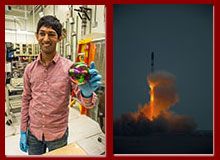
Student Research Opportunities in HEPL Facilities

On this Page:
Graduate Student Research Opportunities
Stanford graduate students should contact HEPL faculty members directly to inquire about research assistanships and other research opportunities in their labs and projects.
Undergraduate and High School Research Opportunities
Occasionally, HEPL offers summer internships and/or research positions for undergraduate students—and sometimes, for high school students. Undergraduate and high school students may inquire about the availability of such positions by sending an email to Nancy Christiansen, Administrative/Managing Director of HEPL Labs.
University Resources Related to Student Research
The Stanford Office of Science Outreach maintains a list of internships and other opportunities for student summer research. Following are some links to various university student research opportunities:
- Stanford Office of Science Outreach
- Graduate Student Assistanships
- Undergraduate Student Employment
- Stanford Student Services Center
HEPL Student Research Profiles

Left: HEPL doctoral candidate, Karthik
Balakrishnan
holds a spherical proof
mass from his UV-LED charge control
experiment in the lab. Right: A Russian-
Ukranian Dnepr rocket launches
Karthik's experiment, housed in a Saudi
Arabian satellite, into orbit.
June 19, 2014 — HEPL PhD Candidate, Karthik Balakrishnan's Charge-Control Experiment is Flight Certified at NASA Ames, Integrated into a Saudi Arabian Satellite and Launched into Orbit Aboard a Russian-Ukrainian Rocket
Given the current political state of the world, you might think that the headline above describes a doctoral candidate’s pipe dream. However, back on June 19, 2014, this satellite launch event actually happened!
Karthik Balakrishnan is a doctoral student in the Aeronautics and Astronautics Department of Stanford’s School of Engineering. His research on charge control systems for satellite guidance is sponsored by HEPL and the Center for Excellence in Aeronautics and Astronautics (a collaboration between Stanford and the King Abdulaziz City for Science and Technology in Saudi Arabia), and it is being carried out in the laboratory of Robert Byer, Professor of Lasers and Optics in Stanford’s Department of Applied Physics. Professor Byer is also a former director of HEPL. Mr. Balakrishnan’s experimental apparatus uses low-power, ultraviolet frequency LEDs to remove electrostatic charge buildup from a baseball-sized, gold-coated sphere comprising the guidance control mechanism that enables a satellite to circle the Earth (or another planet or the Sun) as a gravitational reference sensor (GRS). Read Full Story...
